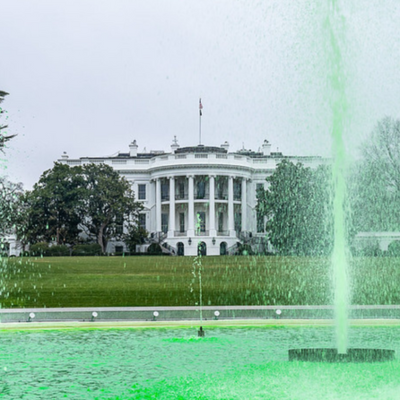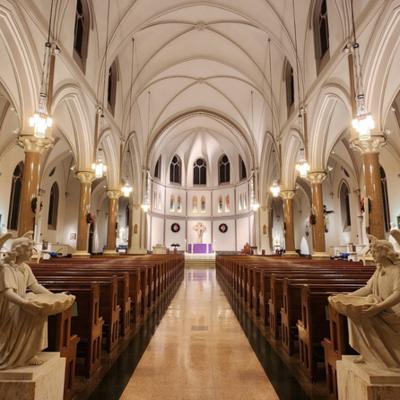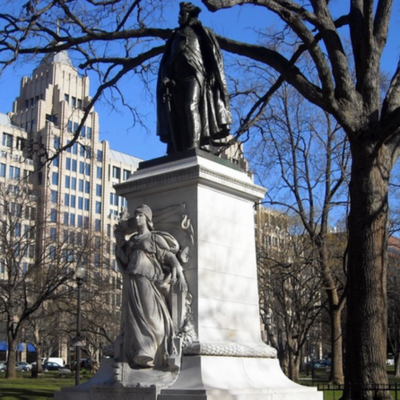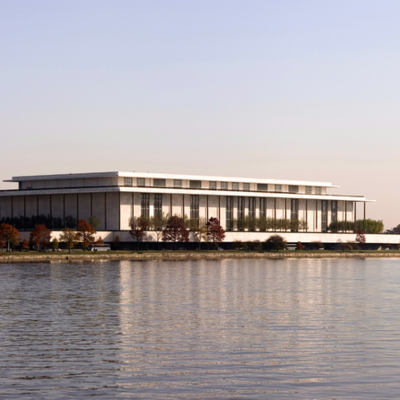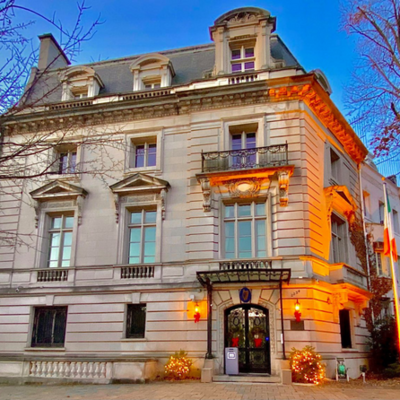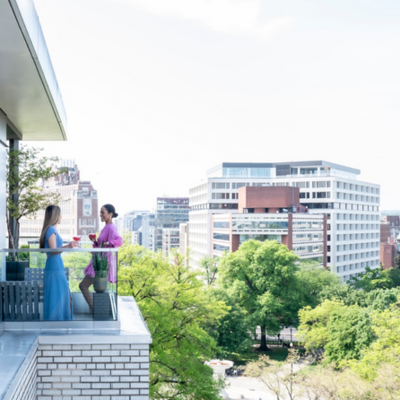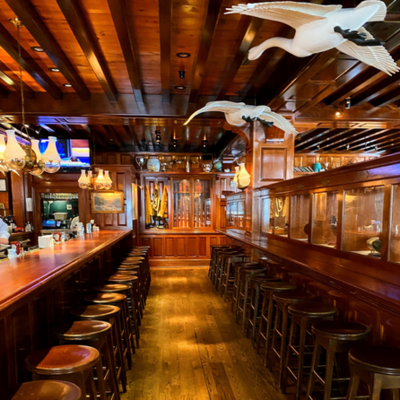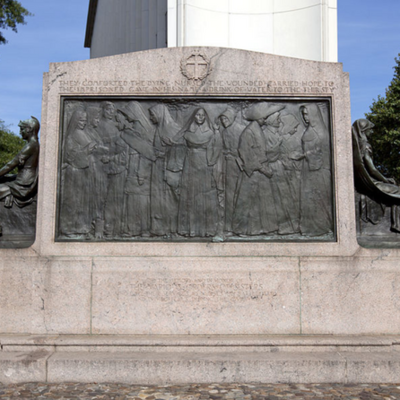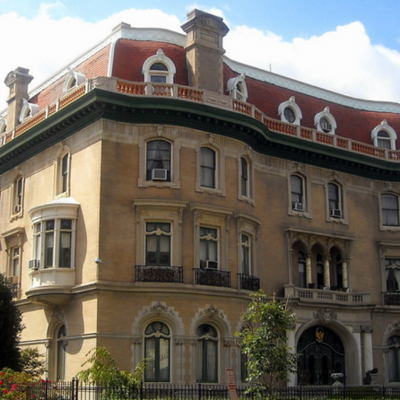The White House
The White House, the official residence of the President of the United States, was designed by Irish-born architect James Hoban. Hoban was born in Kilkenny, Ireland, and immigrated to the United States in 1785. He won a competition to design the White House in 1792 and oversaw its construction. Discover the life and legacy of James Hoban in the book, "
James Hoban: Designer and Builder of the White House" by White House Historical Association President Stewart D. McLaurin
|
St. Patrick's Catholic Church
St. Patrick's Church in Washington, D.C. is the oldest parish in the city and was originally founded in 1794 to serve the needs of Irish immigrants who were working on the construction of The White House and the Capitol building. The original church building was a small wooden structure, but it was replaced in 1809 with a brick church that could accommodate a growing congregation. Over the years, St. Patrick's continued to expand and renovate its facilities to meet the needs of its parishioners. The church played an important role in the lives of Irish immigrants in the city, providing them with a sense of community and a place to worship. Today, St. Patrick's Church remains an important landmark and continues to serve as a spiritual home for Catholics in the city. Its rich Irish heritage is still evident in the church's architecture, artwork, and traditions, including an annual St. Patrick's Day mass and parade.
|
John Barry Memorial
The John Barry Memorial honors John Barry, an Irish-born officer in the Continental Navy who is considered the "Father of the American Navy." The memorial features a bronze statue of Barry and an inscription in both English and Irish.
John Barry was an American naval officer and the founder of the United States Navy. He was born in Ireland in 1745 and emigrated to the United States as a young man. Barry is considered a hero of the American Revolution for his bravery and leadership during naval battles against the British.
Aside from his success in the American Navy, Barry was also involved in the founding of the first Catholic parish in Philadelphia. He is also played an important role in supporting the Irish community in the United States, advocating for Irish independence, and helping to fundraise for the cause.
Today, John Barry is remembered as one of the most important figures in the history of the United States Navy and as a symbol of the contributions that Irish immigrants have made to American society. The US Navy continues to honor Barry's legacy, with several ships named after him, including the USS Barry, which is an Arleigh Burke-class guided missile destroyer that was commissioned in 1992 and remains in active duty.
|
Washington Monument
The construction of the Washington Monument, one of the most iconic landmarks in the United States, involved the efforts of many different people, including a significant number of Irish immigrants. When work on the monument began in 1848, Irish workers were recruited to help with the excavation and foundation work. Many of these workers were recent immigrants who had come to the United States to escape poverty and famine in Ireland. The Washington Monument stands as a testament to the hard work and dedication of all those who helped to build it, including the Irish immigrants who played a vital role in its construction.
|
The Kennedy Center
The John F. Kennedy Center for the Performing Arts, commonly known as the Kennedy Center, is a world-renowned performing arts center located in Washington, D.C. It was established as a living memorial to President John F. Kennedy and was opened to the public in 1971. The Kennedy Center is one of the busiest performing arts centers in the world, hosting a wide range of music, theater, dance, and opera performances throughout the year. It is home to the National Symphony Orchestra and the Washington National Opera, and it also hosts a variety of touring acts and productions. In addition to its performance spaces, the Kennedy Center also includes an extensive art collection, as well as several restaurants and cafes. It is considered one of the cultural highlights of Washington, D.C. and a must-visit destination for lovers of the performing arts.
|
Irish Embassy
The Irish Embassy is located on Massachusetts Avenue and is the official diplomatic mission of Ireland to the United States. The embassy building was designed by Irish architect Michael Scott and opened in 2001.
|
Dupont Circle
Dupont Circle is a popular neighborhood in DC known for its shops, restaurants, and nightlife. The neighborhood was named after Samuel Francis Du Pont, a US Navy admiral of French Huguenot and Irish descent.
|
Old Ebbitt Grill
A popular restaurant and bar in D.C., The Old Ebbitt Grill has a rich history. The building that houses the restaurant was built in 1856 and was originally a boarding house for Irish immigrants. Today, the Old Ebbitt Grill is a popular spot for politicians, tourists, and locals alike.
|
The Nuns of the Battlefield Monument
The Nuns of the Battlefield Monument is a bronze statue located in Washington, D.C.'s Catholic University of America. It was designed by Irish-born sculptor Jerome Connor, who was also responsible for several other prominent works of art in the city. The monument was commissioned by the National Order of Sisters of the Holy Cross in recognition of the contributions made by Catholic nuns during the American Civil War. Connor's design depicts three nuns in traditional habits tending to a wounded Union soldier, with a fourth nun looking on in prayer. The statue was unveiled in 1924 and remains an important symbol of the role played by women in the Civil War.
|
Indonesian Embassy
The 50-room mansion in Washington, D.C., was commissioned by Thomas F. Walsh, an Irish-born American businessman, and built by architect Henry Andersen from 1901 to 1903. The stunning mansion, which cost $853,000 to construct at the time (equivalent to about $20 million in 2008), features a blend of architectural styles, including Renaissance Revival and French Baroque. Home now to the Indonesian Embassy, the mansion is a testament to the grandeur and wealth of America's Gilded Age, as well as to the enduring legacy of Irish immigrants who helped build the United States. Washington, D.C. is a city filled with history, and it is no surprise that it has many landmarks and sites with Irish ties. From St. Patrick's Church, which dates to the mid-19th century, to the Irish Embassy, which represents Ireland's interests in the United States, there are many places in and around D.C. that celebrate Irish culture and heritage. Whether you're interested in learning about Irish American history or simply want to experience some of the Emerald Isle's influence on the nation's capital, these landmarks provide an excellent starting point.
|
